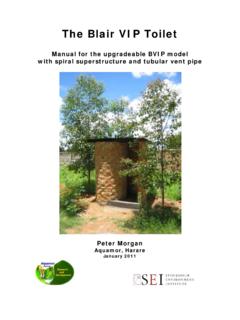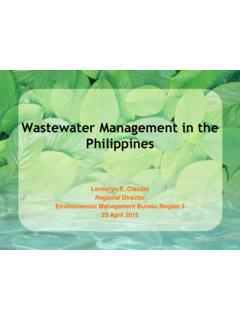Transcription of What Happens When the Pit is Full?
1 FSM Seminar14-15 March 2011, Durban, South AfricaSeminar ReportWhat Happens when the Pit is Full? Developments in on-site Faecal sludge Management (FSM)Seminar Report: what Happens when the Pit is Full? Table of ContentsIntroduction1 Seminar Objective 1 Content Highlights2 Opening Address and Introduction3 Session 1: what Happens when the pit is full? A trillion dollar question, and an urgent one5 Session 2: Inside the pit9 Session 3: Getting what s inside outside16 Session 4: Mechanised emptying for SMMEs21 Session 5: Grasping the nettle eThekwini s Pit Emptying Programme25 Session 6: The sludge disposal issue32 Annex A: Agenda38 Annex B: List of participants40 Annex C: Sources and websites for more welcome and opening welcome and for the billions.
2 Making it work in the global future of on-site sanitation. Beyond the fast do pits and septic tanks fill up? Implications for design and is going on inside pits and septic tanks? The science of sludge under the microscope. The Ascaris Muthis. Can biological additives make the problem go away? you need to know about emptying pits and tanks with vacuum tankers, large and Search of Innovations in Pit with pit emptying in the Eastern Cape: the Franchise quest for sustainable sanitation in PETshop toys. Of eVacs, Nanovacs and from eThekwini s Pit Emptying Programme from pilot to full disposal in eThekwini. Reviewing the sludge disposal with benefits?
3 Deep-row entrenchment with do no harm: how do we protect the workers and the public during the process? critical cost consideration. sludge transfer and waste: for how long can we afford to throw it away? with Urban sludge Treatment in for local government of faecal sludge management37B&MGFBill & Melinda Gates FoundationBEEB lack Economic EmpowermentBORDAB remen Overseas Research Development AssociationBPDB uilding Partnerships for DevelopmentCBOsCommunity Based OrganisationCLTSC ommunity Led Total SanitationCODC hemical Oxygen DemandCSIRC entre for Scientific and Industrial ResearchDALYSD isability Adjusted Life YearsDEWATSD ecentralised Wastewater Treatment SystemsEAWAGE igen ssische Anstalt f r Wasserversorgung, Abwasserreinigung und Gew sserschutz (Swiss Federal Institute for Environmental Science & Technology)
4 EWBE ngineers Without BordersEWSE thekwini Water ServicesICCI nternational Convention CentreIDEI nternational Development Enterprises LCDL iquid Crystal DisplayLSHTML ondon School of Hygiene and Tropical MedicineNGONon Governmental OrganisationO&MOperations and MaintenancePHASTP articipatory Hygiene and Sanitation TransformationPIDP artners In DevelopmentPSAPit sludge AugerSASouth AfricaSADCS outhern African Development CommunitySMMEsSmall, Medium and Micro EnterprisesUDUrine DiversionVIDPV entilated Improved Double Pit latrineUKZNU niversity of Kwa Zulu NatalUNUnited NationsUN-HabitatUnited Nations Human Settlements ProgrammeUSDU nited States DollarsVIPV entilated Improved Pit latrineWISAW ater Institute of Southern AfricaWRCW ater Research CommissionWWTPW aste Water Treatment PlantZARS outh African Rand (Zuid-Afrikaanse Rand)Abbreviations1 South Africa has recently held what has been called the Toilet Election.
5 Amidst a welter of recriminations, debates about 'open toilets' have reaffirmed the elemental importance of sanitation and the unbreakable link between human dignity and adequate sanitation. what comes next remains to be seen, but surely it cannot exclude a renewed focus in South Africa, and perhaps in the region, on this most basic of human sanitation is one of the Millennium Development Goals, many regions are performing poorly in attaining their declared sanitation targets, including Sub-Saharan Africa. Whilst much of the focus is, understandably, on the provision of new toilets, the maintenance of those toilets already built cannot be forgotten.
6 Take South Africa as an example, where there are around 2 to 3 million 'VIP' latrines. While the government there has recognised that maintaining its commitment to sanitation as a basic human right means continuing to keep existing toilets operational (as well as providing new ones) it has left it to local government structures to work out how this should be done. Most municipalities do not as yet have policies, budgets or procedures for the maintenance of on-site sanitation. A rough estimate suggests that in the rest of SADC there are perhaps another 5 million 'urban' latrines, many of which will also need emptying within five years or less of urban areas it is much rarer for new pits to be dug once old latrines fill (for a variety of reasons).
7 The issue of how to manage the faecal sludge accumulating in urban latrines is therefore a crucial one. Traditionally this is an issue that has attracted relatively little attention and had little prestige. Historically it has also been an area of limited the challenge of faecal sludge management (FSM) grows, things are changing however. Recent years have seen a flourishing of innovation across a range of issues. This has bettered our understanding of what Happens in pit latrines, how sludge accumulates and degrades and how it can best be managed. New ways of getting sludge out of pits, in a more hygienic and efficient manner, are being pioneered in many countries worldwide.
8 The final link in the chain, the important issue of how to deal with the sludge collected, is also under the spotlight, with new or better ways of dealing with pit sludge city of Durban has been a focal point for much of this innovation and learning and was therefore an appropriate place to gather a range of practitioners dealing with FSM. In March 2011 approximately 140 participants gathered - from local government, NGOs, research organisations and academia in order to discuss the latest developments and share experience across four continents. This note captures the proceedings of the two day seminar, hoping to share some of the insights discussed and make research, learning and best practice available to a wider objective of the seminar was to enable anyone responsible for the sustainable operation of on-site sanitation systems to find out about new developments in the field, and to share their experience with counterparts from elsewhere in Southern Africa and the ObjectiveSeminar Report: what Happens when the Pit is Full?
9 2 The seminar was split across six sessions and ended with two field visits (hosted by eThekwini's Water and Sanitation Department, EWS). The sessions ran as follows:Introduced faecal sludge management as an issue and discussed some of the latest developments in the sector not only in removing and treating sludge from pits but discussing broader developments in sanitation approaches that will influence the shape of FSM approaches in the years to come. Talked about what Happens inside pits and how sludges accumulate and degrade. It also discussed the pathogenic nature of the contents and the consequences of this for managing the waste streams generated.
10 It discussed whether current 'pit additives' on the market offer potential in addressing the problem inside the pit, reducing the need to extract and treat of innovations in pit emptying both in the technology used to do so and also in the operational approaches followed. Showcased new experience both in South Africa and further afield that offers great potential of better ways to get waste from pits and ensure that it is dealt with existing practice and options regarding the mechanised emptying of latrines as well as more recent developments. The session also showcased recent innovation in emptying techniques, then trialling of new machines and their potential.







